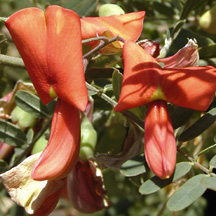|
In The Garden
Guest Writers
|
Tree varies across isles
Ohai
Sesbania tomentosa form arborea
Description: Small, upright trees 10 to 18 feet tall with evenly pinnate leaves, meaning they have an even number of leaflets on each compound leaf. Young leaves also have shiny, golden hairs on the surface, an evolutionary adaptation to help reflect the sun and not dry out. The hairiness is called "tomentose," which is how this plant gets its species name.
 HUI MA KAOLI OLA
Ohai is available at garden stores such as Home Depot for about $9.50.
|
|
The flowers are pea-flower shape and about 2 inches long. They emerge in clusters of one to five and are bright orange with varying streaks of yellow and red. Once the flowers are pollinated, narrow seed pods form, filled with small, greenish-brown seeds.
Distribution: Ohai are found on all the main islands, as well as Nihoa and Necker in the Northwestern Hawaiian Islands. Each island's population varies significantly in morphology (physical appearance), yet they are all treated as the same species. Generally, all are either low-prostrate crawlers or shrubs no more than 3 feet tall. They usually live near the coast in sunny, dry locations, and all are endangered in the wild. This variety, however, is the most significant in terms of being different from the rest. It is found only on Molokai, is three to five times taller than the rest, and its natural range is a little higher in elevation, although it still exists in dry habitats.
Cultural uses: The beautiful flowers of this plant are used in lei-making and can be strung in the same style as a Maunaloa orchid lei.
Landscape use and care: These small trees look great in landscapes and can be planted as specimens or in rows. The tree being so small, the flowers are usually at eye level, which makes viewing easy. Plant them in full sun, in soil that easily dries out. If overwatered, the leaves will yellow, wilt and fall off.
Also, look out for shiny black stink bugs on the plant. They look like black and gold ladybugs, but trust me, they're not; no lady would ever dish out a smell like that. Generally, they don't harm the plant, but you can get rid of them by shooting the plant with water or spraying it with a mild pesticide.
Rick Barboza co-owns Hui Ku Maoli Ola, a native Hawaiian plant nursery, with Matt Schirman. Contact him at 259-6580 or e-mail
rickbarboza@aol.com.

